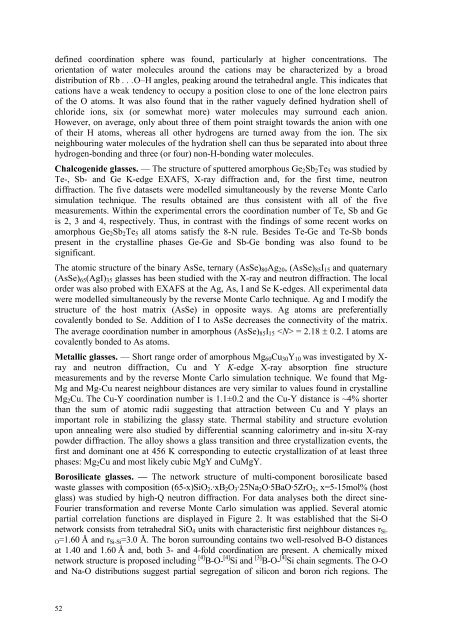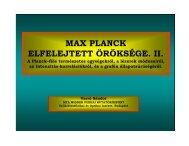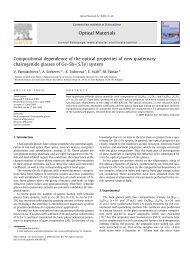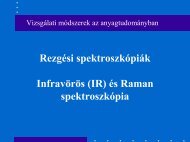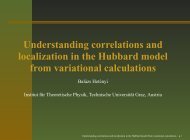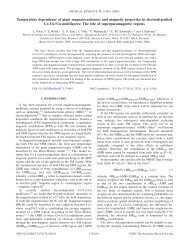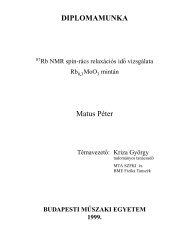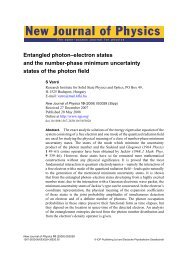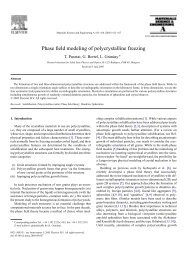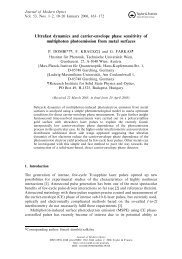ANNUAL REPORT - MTA SzFKI
ANNUAL REPORT - MTA SzFKI
ANNUAL REPORT - MTA SzFKI
You also want an ePaper? Increase the reach of your titles
YUMPU automatically turns print PDFs into web optimized ePapers that Google loves.
defined coordination sphere was found, particularly at higher concentrations. The<br />
orientation of water molecules around the cations may be characterized by a broad<br />
distribution of Rb . . .O–H angles, peaking around the tetrahedral angle. This indicates that<br />
cations have a weak tendency to occupy a position close to one of the lone electron pairs<br />
of the O atoms. It was also found that in the rather vaguely defined hydration shell of<br />
chloride ions, six (or somewhat more) water molecules may surround each anion.<br />
However, on average, only about three of them point straight towards the anion with one<br />
of their H atoms, whereas all other hydrogens are turned away from the ion. The six<br />
neighbouring water molecules of the hydration shell can thus be separated into about three<br />
hydrogen-bonding and three (or four) non-H-bonding water molecules.<br />
Chalcogenide glasses. — The structure of sputtered amorphous Ge 2 Sb 2 Te 5 was studied by<br />
Te-, Sb- and Ge K-edge EXAFS, X-ray diffraction and, for the first time, neutron<br />
diffraction. The five datasets were modelled simultaneously by the reverse Monte Carlo<br />
simulation technique. The results obtained are thus consistent with all of the five<br />
measurements. Within the experimental errors the coordination number of Te, Sb and Ge<br />
is 2, 3 and 4, respectively. Thus, in contrast with the findings of some recent works on<br />
amorphous Ge 2 Sb 2 Te 5 all atoms satisfy the 8-N rule. Besides Te-Ge and Te-Sb bonds<br />
present in the crystalline phases Ge-Ge and Sb-Ge bonding was also found to be<br />
significant.<br />
The atomic structure of the binary AsSe, ternary (AsSe) 80 Ag 20 , (AsSe) 85 I 15 and quaternary<br />
(AsSe) 65 (AgI) 35 glasses has been studied with the X-ray and neutron diffraction. The local<br />
order was also probed with EXAFS at the Ag, As, I and Se K-edges. All experimental data<br />
were modelled simultaneously by the reverse Monte Carlo technique. Ag and I modify the<br />
structure of the host matrix (AsSe) in opposite ways. Ag atoms are preferentially<br />
covalently bonded to Se. Addition of I to AsSe decreases the connectivity of the matrix.<br />
The average coordination number in amorphous (AsSe) 85 I 15 = 2.18 ± 0.2. I atoms are<br />
covalently bonded to As atoms.<br />
Metallic glasses. — Short range order of amorphous Mg 60 Cu 30 Y 10 was investigated by X-<br />
ray and neutron diffraction, Cu and Y K-edge X-ray absorption fine structure<br />
measurements and by the reverse Monte Carlo simulation technique. We found that Mg-<br />
Mg and Mg-Cu nearest neighbour distances are very similar to values found in crystalline<br />
Mg 2 Cu. The Cu-Y coordination number is 1.1±0.2 and the Cu-Y distance is ~4% shorter<br />
than the sum of atomic radii suggesting that attraction between Cu and Y plays an<br />
important role in stabilizing the glassy state. Thermal stability and structure evolution<br />
upon annealing were also studied by differential scanning calorimetry and in-situ X-ray<br />
powder diffraction. The alloy shows a glass transition and three crystallization events, the<br />
first and dominant one at 456 K corresponding to eutectic crystallization of at least three<br />
phases: Mg 2 Cu and most likely cubic MgY and CuMgY.<br />
Borosilicate glasses. — The network structure of multi-component borosilicate based<br />
waste glasses with composition (65-x)SiO 2 .·xB 2 O 3·25Na 2 O·5BaO·5ZrO 2 , x=5-15mol% (host<br />
glass) was studied by high-Q neutron diffraction. For data analyses both the direct sine-<br />
Fourier transformation and reverse Monte Carlo simulation was applied. Several atomic<br />
partial correlation functions are displayed in Figure 2. It was established that the Si-O<br />
network consists from tetrahedral SiO 4 units with characteristic first neighbour distances r Si-<br />
O=1.60 Å and r Si-Si =3.0 Å. The boron surrounding contains two well-resolved B-O distances<br />
at 1.40 and 1.60 Å and, both 3- and 4-fold coordination are present. A chemically mixed<br />
network structure is proposed including [4] B-O- [4] Si and [3] B-O- [4] Si chain segments. The O-O<br />
and Na-O distributions suggest partial segregation of silicon and boron rich regions. The<br />
52


